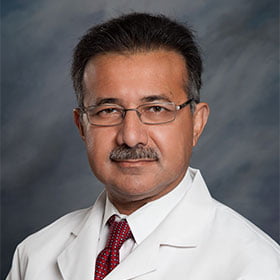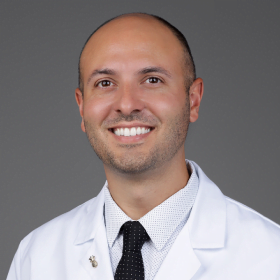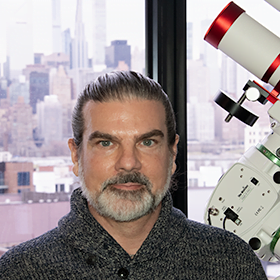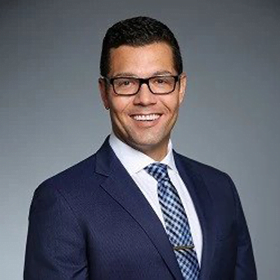Dr. Paul Romesser is a board-certified radiation oncologist at Memorial Sloan Kettering Cancer Center in New York City. He has expertise in using advanced techniques to treat cancer. These include image-guided radiation therapy, intensity-modulated radiation therapy, stereotactic radiosurgery, and proton beam radiotherapy. He is also actively involved in anal cancer clinical trials. Dr. Romesser is a member of the NRG Oncology colorectal and non-colorectal gastrointestinal cancer committees and the National Cancer Institute’s Rectal-Anal Task Force. His work has been published in Nature, Science, Lancet Oncology, Clinical Cancer Research, International Journal of Radiation Oncology and Biophysics, and Cancer.
Types of Radiation for The Treatment of Anal Cancer and Support After Treatment
Can you explain what type of radiation is best for anal cancer patients?
In radiation, we use a lot of acronyms and that can get confusing for patients. We say VMAT because Volumetric Modulated Arc Therapy is a mouthful, and no one can remember that. The acronyms can be confusing for patients when evaluating different types of treatment. The standard type of radiation for anal cancers is IMRT or Intensity Modulated Radiation Therapy. In a large-national trial, it was shown that IMRT lowered certain gastrointestinal, genital, and urinary symptoms as compared to the former type of treatment which is 3D Conformal Radiation or 3D CRT. And so certainly you want to make sure you’re getting, at a minimum, IMRT.
VMAT is a version of IMRT that’s just slightly more technologically advanced that uses arc therapy. And so that’s a further iteration of IMRT.
In addition, to VMAT, it’s best to also get image guidance radiation where daily pictures or X-ray images of the patient on the table are taken to make sure that they’re in the correct anatomical position every day. This is important because it decreases day-to-day setup variation, which allows the radiation fields to be more focused and directed. So that’s what patients should really look for, image-guided VMAT radiation.
Now there are also new and emerging types of radiation techniques and some, like proton therapy, are heavily marketed. There’s no data in anal cancer now suggesting that proton therapy provides any clinical benefit over Intensity Modulated Radiation Therapy or VMAT. In fact, when some patients with breast cancer actually went from IMRT or 3D Conformal radiation to proton therapy, the results were not good. There have actually have been some papers published on how the techniques and the physics of these two types of treatments led to some increased risk of recurrence in some breast cancer patients. So, this is still part of a learning curve. Fortunately, now proton treatment for breast cancer is more standardized and being evaluated in a large national randomized trial. Will clinical studies show that proton therapy for anal cancer is equal or better at reducing the side effects? This is something that needs to be researched, but there is no clinical basis for this yet. But again, I think that will be informative in the future in terms of what the benefit is and where proton treatment fits in in terms of treating anal cancer.
So, to sum up, if you were to give simple advice to a newly diagnosed anal cancer patient, would you tell them to look for IMRT-VMAT image-guided radiation?
IMRT or VMAT with image guidance would be the main thing they should look for.
Also, they should ask their radiation oncologist what type of machine they’re going to be treated on. The answer may not mean anything to the patient, but it may be interesting to see the doctor’s thoughts about the machine they’re using.
And it would be interesting to ask the doctor how many patients with anal cancer they treat a year and what their outcomes typically are. What are their patients’ long-term side effects like? Also ask whether they use vaginal dilators during radiation and also ask about support for overall function after you finish radiation treatments because another big thing is seeing if they have a standard policy or standard procedure for referring patients to pelvic floor physical therapy, to women’s sexual health and men’s sexual health. I recommend finding out whether the cancer center has a comprehensive program of providers, and a team to take care of you as an anal cancer patient.
Radiation Machines
Going back to the question of machines for a moment, is there anything newly diagnosed patients should know about the types of machines that a cancer center has?
The types of machines are very complex; even if the machine has the same name, there are many different types of that machine. And so there’s a lot of complexity at that level. I don’t know if I would worry too much with the type of machine. I’ll give you an analogy of a Ferrari. A Ferrari is only as good as the driver. Sometimes you don’t need a Ferrari. I’d argue you don’t need a Ferrari to drive around New York City, but we still see plenty of them. So, it’s really more about how you use the machine and the expertise of the driver. And as long as the driver feels that they have the adequate machine to do the job, they will be able to do it.
Disparities in Long-Term Side Effects Amongst Patients
Why do some people have such severe long-term side effects from anal cancer treatment while others don’t?
Staging is one component of it. Because we use different radiation doses for different stages, if you have a more advanced stage, you’re going to get a higher radiation dose than if you have an early stage, and that’s just because you need more radiation to kill a bigger tumor. In addition, the location of your lymph nodes influences the long-term side effects. If you have lymph nodes involved, it may also dictate some of your side effects. The size of cancerous lymph nodes is also important because those might also need to be targeted with higher radiation, or radiation of a certain part of the body may be required.
Another thing that may contribute to varying side effects is just that there’s a baseline variability in how patients respond with radiation. Some patients handle it very well and don’t have any long-term side effects; others might have some sort of unknown, underlying susceptibility to radiation, a worse tolerance for it. Generally speaking, those underlying radiation sensitivities are very very very rare, well less than 1% of patients. But we do see this, so as a radiation oncologist, this is one of the reasons we meet with our patients. We check in with them and make sure everything’s going well.
But another thing that contributes to this is also likely the experience of the radiation oncologist because it’s not a cookie cutter approach. When we have a patient, we’re designing an individual treatment plan for that patient. So as a patient, you’ll come in, you’ll have your radiation mapping or simulation scan, and then you go home and then the radiation starts a couple of days later. But what happens in that interim is kind of this unknown for patients. Essentially your radiation oncologist performs, for lack of a better word, radiation surgery on your digital images. While you’re at home watching TV, eating dinner, or going for walks, that’s what we’re doing, and we’re working with our team of medical physicists to optimize your plan. We’re then presenting your plan to our colleagues, in my case, to get peer review, and so each treatment plan is different for every patient. And if you actually took the same patient to a different radiation oncologist, you would get to some degree of differences in the plan and targeting. Now we hope that that difference in plan and targeting is within what we consider acceptable variations. That’s why we as a profession of radiation oncologists do something called board certification; we make sure that practicing physicians are board certified, meaning that they can pass competency exams, and that’s certainly something you should ask your doctor about. Are you a board-certified radiation oncologist? Because hopefully they are. But, there’s an element of variability of what you would consider normal, so maybe how I design a patients radiation treatment might not be exactly how someone else designs it at a different institution, and that’s okay. But there are also times where maybe someone else would design it in a way that I would think would be really not okay, because it wouldn’t be within what I would consider normal. And so that’s why I was highlighting earlier that I think going to doctors who have expertise and experience with anal cancer really provides an advantage for patients to make sure they’re getting the absolute highest level of quality care that they can get.
Oral Chemo
Even though you’re not a medical oncologist, I wanted to ask about chemo. For me it was very important to get oral chemo. Can you speak about why some people get chemo through a port or PICC line but other people get oral chemo? What are the upsides and downsides of each type of chemo?
The oral chemo you are referring to is Capecitabine, also known as Xeloda. It’s an oral prodrug of 5-FU which means that it’s a drug that is converted into essentially 5-FU by your liver. The port is a venous access device for 5-FU. So, these are just two ways of getting essentially the same medicine in the body. But these two aspects do have different potential side-effect profiles. I’ll come back to that in a minute.
It used to be, before Capecitabine, Xeloda, was developed, that 5-FU was the standard that everyone got. Now in rectal cancer, they did a study. They compared 5-FU with oral Capecitabine, and they found there to be no difference in terms of the efficacy of the drug. And so now in rectal cancer, many patients are getting the Capecitabine instead of the 5-FU, and we’ve extrapolated that to our anal cancer studies as well. So now, for us, our standard is the oral chemotherapy pill for both patients who are getting anal cancer treatment and also for patients with rectal cancer who are getting long-course chemoradiation. We believe them to be oncologically equal in terms of their efficacy. Now there are some situations where we might recommend the port chemotherapy over oral chemotherapy. If a patient has certain medical conditions and can’t swallow pills or has difficulty holding pills or seeing them, that would be one reason. There can be a slightly higher risk of some different types of chest pain when you take the oral chemotherapy pills. So certain medical comorbidities or medical conditions might make your medical oncologist lean more one way or the other. And if that’s the case, I would take the advice of your medical oncologist because they have your best interests at heart. Now not everywhere in the United States has moved from the port-based chemo to the oral chemotherapy pills for reasons that are unknown to me. So it may be that at some center they prefer one or the other. And you should ask your medical oncologist why they prefer that versus the other. But in our center, routinely for anal cancer, unless there’s a specific reason, our standard is oral Capecitabine.
Treatment Duration
How many days of radiation do patients usually get?
The days vary by stage but it’s generally a range of 23 to 30 treatments. I don’t want to give an exact answer because different centers might be slightly different. It might be slightly more or less days at different centers, but that’s all within that range of acceptable deviations that I discussed earlier. I can’t say that at this stage you get this or that number of days because there are acceptable deviations with this.
Can you explain why some anal cancer patients are told to have a full bladder during radiation?
A full bladder pushes your small intestine out of your pelvis. So, when we treat anal cancer, we not only have to treat the areas that are involved, we also have to treat certain areas that are uninvolved that might be at high risk for lymphatic spread. Often, this includes the pelvic lymph nodes and the lymph nodes in the groin. And so when you treat the pelvic lymph nodes, if your small intestine is there, you might be at a higher risk of developing certain small intestinal side effects, things like bleeding or strictures or abdominal adhesions in the future. And so one way to circumvent this is for the treatment team to have you drink some water and wait 30 minutes or 45 minutes, and then do your treatment. Now there are pros and cons for full bladder. The pro is that it should limit the dose to your small intestine. But in some patients, there’s no problem with the small intestine because it’s already not in the pelvis. So, some patients don’t actually need a full bladder. And I will argue, in those patients, treating them with full bladder just adds anxiety to the treatment because then they feel like their bladder has to be really really full to get the maximum benefit. And it might be a bit uncomfortable on the table, or if treatment takes long that day, they might have to get off and even go to the bathroom. And towards the end of treatment, when they’re having side effects, it might not be that fun to be sitting there squirming on the table waiting for treatment.
And so generally, there are three approaches: some centers treat everyone with a full bladder; others treat no one with a full bladder; and the third approach, which is my approach, is to treat only patients who need full bladder with full bladder, meaning if I look at the planning scan, and I evaluate if the patient would benefit from full bladder, that’s what we’re going to do. And that’s how I’m going to treat that individual patient. And so, I use it more specifically based on the individual patient’s need, tailored to that patient’s anatomy. It’s not wrong to do it on every patient; it just may not be needed. I don’t think it can cause any harm. But it might just add a little bit of anxiety to an already anxiety-provoking experience. So, I would encourage patients to ask their radiation oncologist if they use full bladder and if they do when they do it, just to get an understanding. To me, it would be a red flag if a radiation oncologist says they never use full bladder. Why would they do that?
Vaginal Dilators During Treatment
Can you tell me about the purpose of the vaginal dilator that is sometimes used during radiation? Is that a new technique? I am wondering why some cancer centers use them, but others don’t.
What we found when we looked back at our follow ups with female patients was that many of them complained about pain with penetration of the vagina. So, this got us thinking about the potential long term-side effects of radiation on sexual function and vaginal health. So, we know that we can lower the dose of radiation to the vagina and also to the sensitive parts of the female anatomy, meaning the clitoris and the vaginal hood, by displacing them or moving them further away from the radiation field. And this also helps us limit the dose to the anterior vaginal canal because the dilator by definition will separate and open up the vagina. And so, early studies done, at MD Anderson Cancer Center, looked at the radiation dose to the vagina and clitoris with and without the dilator. What they found was that the dose to these sensitive women parts as well as to the anterior vaginal canal were lower with the use of a vaginal dilator. And so, there’s really no data showing yet that this lowers the side effects from the treatment. But we do suspect that because of the lower dose, it will lower the side effects. And so at Memorial Sloan Kettering Cancer Center, because this is a low cost, relatively straightforward intervention, we’ve opted to make this routine on all of our patients who we treat here.
So, is there any official study being done on this where they track outcomes or not yet?
Not yet, because most centers don’t have volume to show results. The volume to show this would require hundreds of patients with anal cancer, but with anal cancer being a rare disease, it’s hard enough to get trials successfully approved to show a benefit in terms of treatment outcomes. So, something like this would be a much larger initiative. It would have to be many institutions coming together or a single institution like our own where we made an abrupt change, and then looking at those outcomes carefully.
So the reason that many cancer centers aren’t doing this is because there’s no official study and it’s not in the protocols for treatment right now?
Most are probably not doing it because they probably don’t know about it and are uncomfortable discussing this with patients, and helping them understand why we do it and why it’s important. In addition, to implement this routinely adds time and complexity to treatment and some centers might not have the necessary staff and expertise. But in my mind, it’s an extra added step that can only help patients and not hurt them. And because of the excellent outcomes of our patients and because of our focus on long-term quality of life and helping all of our patients or hopefully all of our patients return to a very rewarding ordinary life after we cure them of their cancer, it’s one that we find to be very important to our mission.
Interesting, that’s really good for people to know because some people might want to seek out places that offer this. Is there any way patients who are recently diagnosed could find out which cancer centers offer this?
It’s a good question for them to ask when they’re meeting with their radiation oncologist. Do you use vaginal dilators? And if not, why not? These are things that I think that patients should be using as a kind of metric when evaluating where they want to get their care. You want to get your care from a doctor who’s compassionate, empathetic, and has experience in treating anal cancer, and you want to get your care from a center or institute that has expertise in treating your type of cancer. It has been shown, not in anal cancer but in other types of cancers like head and neck, that when you go to a center with expertise in your type of cancer, with a high volume of treating your type of cancer, that clinical outcomes are better. In fact, so much better that it’s been shown that there are survival benefits. So, we’re talking about really kind of the highest level of potential benefit in choosing an experienced center over maybe what some might consider a more convenient center, which is you know, the mom-and-pop center down the street.
Is there anything men should know about sexual health and anal cancer treatment?
I think it’s equally important for men to have these discussions about long-term sexual side effects and function. Just like we use the vaginal dilators for women, there are approaches we can take for male patients that may help reduce sexual dysfunction after treatment. There are also providers who specialize in men’s sexual health. If they’re having problems after treatment, there are an equal amount of resources available to men as well.
What to look for when selecting a cancer center and what to ask the radiation oncologist.
You mention metrics for evaluating whether a cancer center is good at treating anal cancer. When I was first diagnosed, I went to a cancer center I did not like, but I didn’t know what to look for when seeking a better center. What do you recommend patients who are seeking the best possible care look for?
There is a list of things patients should ask their radiation oncologist.
Are you a board-certified radiation oncologist?
Are you an NCI designated cancer center?
How many anal cancer patients do you treat every year? Generally, what are your treatment outcomes?
What are the sexual health outcomes? How do women or men do?
What type of radiation will I get?
What type of machine do you use?
What type of chemotherapy do you use?
Do you use vaginal dilators during treatment?
Do you treat anal cancer patients with full bladder?
I think it’s important to discuss NCI designated cancer centers. There are 71 NCI-Designated cancer centers in the US. These are centers that the National Cancer Institute or the National Institutes of Health has deemed as centers of excellence. These are centers that have specialties in oncology and likely have expertise, even in rare cancers like anal cancer. I would be very comfortable with patients going to any of the 71 NCI-Designated Cancer Centers in the United States. These are generally considered centers of excellence. Cancer Centers undergo reevaluation every five years to maintain their cancer center status. And there’s an ongoing credentialing, monitoring, and grant evaluation by the NCI. These are usually large academic institution centers; they will have the expertise, the technology, and the teams necessary to provide high-quality care for patients with anal cancer.
If for some reason you’re unable to go to an NCI-Designated Cancer Center, please go to a high-volume private cancer center and make sure that your physician has a lot of expertise treating anal cancer. There are many high-volume, high-quality private practice centers out there and many of these participate in national clinical trials evaluating new treatment options for anal cancer patients. And so, it’s not that you can only get care at an NCI-Designated Cancer Center, but you want to ensure you’re getting care from an expert team.
Just to clarify, would you say that long-term side effects are also improved at these cancer centers?
Yeah, they certainly would have more experience in terms of designing, implementing, and delivering radiation as well as the most comprehensive technology to deliver it. It’s always a tradeoff between what’s necessary versus what’s needed. And so certainly, you would expect them to have lower toxicity rates with that level of expertise. I can say that here at my center, one thing that we do is we do peer review on all of each other’s cases where, essentially when I treat a patient I don’t just sit there, design their treatment, and then hit go. I actually design their treatment and then work with my medical physicists to make the treatment as best as possible which is an iterative process where they’ll come back to me with a plan, I’ll say, “great” but we can make it better, and they’ll come back with an improved plan, and the process repeats itself. It’s an iterative process that requires attention to detail and a good team that communicates well. This process happens multiple times before the radiation plan undergoes quality checks. But then, I also present the final plan to all my other colleagues who treat gastrointestinal radiation. At my center, they all have to give their stamp of approval on my treatment just like I have to give my stamp of approval on their treatment. And we do this not because we have to, because it’s not actually mandated in most centers– 99% of the United States doesn’t do this–we do this because we care about the quality of what we’re delivering. And even though we are very experienced as individual doctors, we know that the collective experience of us together is actually better than any of us individually and so that’s another thing to ask when you’re meeting with your physicians and evaluating places to go is what sort of you know, peer review, or systems are in place to facilitate this.
Hope for The Future
This is good for people to know. Are there any new developments on the horizon when it comes to anal cancer treatments? Is there reason for optimism?
I’m really excited about the future of anal cancer treatment. We are now seeing more and more patients coming on to clinical trials with both early anal cancers and metastatic anal cancer. We’ve seen increased engagement from our industry and pharmaceutical sponsors. We’re seeing increased engagement from The Rare Cancer Network as well as increased engagement from the NCI National Clinical Trials Network. So, we’re seeing lots of trials now evaluating ways that we can better treat anal cancer patients and reduce treatment side effects both short term and long term. So, I’m very excited about these, both in terms of looking at potential strategies for lowering radiation dose or shrinking radiation fields for patients with early-stage node-negative anal cancer, as well as new strategies for incorporating novel immunotherapies, which are therapies that help activate your own immune system to target the cancer, both in the definitive setting in patients with large tumors or tumors involving the pelvic lymph nodes as well as in the metastatic setting. So, I think we’re going to see a lot of advancement happening in anal cancer over the next couple of years, and I assure you that me and all of my colleagues out there, both my colleagues at other academic centers as well as all my colleagues in community practice centers who are very strong supporters of these trials, are working hard to improve outcomes for patients with anal cancer.
Is there anything else a newly diagnosed anal cancer patient should know?
A cancer diagnosis is incredibly scary and it’s normal to have anxiety, it’s normal to start thinking the worst. And I want to assure you that your doctors are there for you. There are also a lot of resources out there in the community for you. There are multiple groups that are happy to engage and set you up to speak with anal cancer survivors to help guide you through what to expect with treatment from a patient to patient perspective, and even to help advise you on places where you can go to get treatment. And so this you can find from the American Cancer Society, at Cancer.com, through the Anal Cancer Foundation or through the HPV Cancer Alliance. These are some excellent, excellent, non-profit organizations who are working to help guide patients like you and I would encourage you to use and reach out to those excellent resources out there.
I have a final question about short-course radiation treatment for anal cancer patients. What would you recommend to a patient who is offered a short-course treatment for anal cancer?
Run away!! I would tell them to run away. Short-course treatment is well known for rectal cancer patients. There have been multiple randomized clinical studies showing what’s called short-course radiation which is one week of five-fraction, five-day treatment and they’ve compared this to what we call long-course chemoradiation in patients with locally advanced rectal cancer who go on to have surgery. But there is very limited data showing that short-course radiation can be used for anal cancer. I would hesitate to allow any patient to get short-course radiation for something like anal cancer where you’re really aiming for a definitive curative treatment. In addition, short course is never used with chemotherapy. And we know that chemotherapy is an important component of the treatment with radiation for anal cancer. I would be very cautious about overly extending these data about rectal cancer to anal cancer and again this is an area where you can’t compromise, you can’t compromise convenience for outcome. The price here would be too high unless it was done in the setting of a clinical trial.





















































